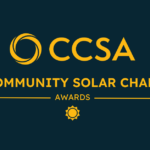Small but mighty, the state of Maryland has long been a national leader in clean energy and climate policymaking, oftentimes exceeding its self-determined emissions reduction goals. Most notably, in 2022, the state’s legislature passed with veto-proof majorities the Climate Solutions Now Act—billed as the “one of the most aggressive” state climate laws in the US—bringing momentum to The Old Line State’s energy transition across the electric power, building heating, and transportation sectors, among others.
Today, it appears that Governor Wes Moore, whose campaign platform included a pledge to accelerate the state’s already ambitious clean energy targets, is determined to not only leverage the momentum afforded by recent state and federal legislation, but ensure that the state enacts policies that will equitably distribute the costs and benefits of rapid decarbonization.
And with the enactment today of Maryland House Bill (HB) 908, Governor Moore is already delivering.
Advocates celebrate this legislation, which the Maryland House of Delegates passed in a 103-37 vote in April, as an affirmation of community solar’s recent record of success in the state. And they say that the law, once implemented by the state’s utility regulator, will “forever ensure that [Maryland residents] reap the climate, economic, financial, and public health benefits of small-scale, distributed solar power,” according to Maryland State Delegate Luke Clippinger (D-Baltimore City), who championed the legislation.
HB 908 achieves this by making permanent the state’s legacy community solar “pilot” program, begun in 2017 following the 2015 enactment of HB 1087, which Del. Clippinger co-sponsored.
The new law removes the “arbitrary cap” on capacity associated with the pilot program, and allows community solar-based generation to be a “permanent option” for customers in the state alongside behind-the-meter solar options such as net metering, according to Charlie Coggeshall, Mid-Atlantic Regional Director at the Coalition for Community Solar Access (CCSA), an industry association. The bill also incentivizes the development of community solar projects on a greater variety of sites, inclusive of commercial rooftops and industrial and brownfield sites, as well as agrivoltaics on farmland.
“By the time the [pilot] program expires at the end of 2024, it will have brought enough solar capacity to support some 90,000 Maryland consumers,” Clippinger said in a statement. “And with the passage of this legislation, we’re one step closer to achieving the state’s clean electricity goals in a way that ensures the financial and economic benefits of community solar reach the communities where they’ll matter most.”
This expansion, together with the removal of the sunset provision from Maryland’s community solar-enabling policy framework, “provides the market with much-needed policy certainty for continued growth of community solar in Maryland,” said Coggeshall. “It leverages the momentum gained from the pilot program as well as best practices established in other states to result in greater and more equitable access to the environmental and economic benefits of solar power.”
Expanding equitable access to the benefits of solar power is a major objective of this legislation according to Clippinger, Coggeshall, and others interviewed for this story. Specifically, the bill includes provisions that require a minimum amount of the electricity generated by Maryland community solar projects, and the associated utility bill credits, be directed to low-income or moderate-income (LMI) subscribers.
HB 908 stipulates that at least 40% of the capacity of new community solar projects be dedicated to benefiting LMI customers, with limited exemptions; facilities that are wholly owned by their subscribers, as opposed to a third-party “subscriber organization” or “subscription coordinator,” as well as projects installed under the preceding pilot program are not covered by this rule.
Maryland State Senator Ben Brooks (D-Baltimore County), a co-sponsor of senate legislation cross-filed with HB 908, underscored for Community Solar News that these equity provisions “sweeten the deal” for prospective community solar project developers. Referring to similar provisions in the U.S. Inflation Reduction Act, Brooks explained that “new and expanded federal tax credits, including attractive ‘bonus credits,’ present enormous opportunity to subsidize project development in the communities that stand to benefit most from such an investment.”
Mirroring nationwide trends, Maryland’s LMI communities are disproportionately affected by steadily increasing costs of living, including inflated energy prices. Moreover, across the country, economically disadvantaged communities have historically been excluded from the benefits of energy transition-related investments from public and private sector institutions. However, advocates agree that ongoing efforts by Maryland lawmakers to enshrine protections and guarantees in clean energy and climate policy will help to mitigate this phenomenon.




